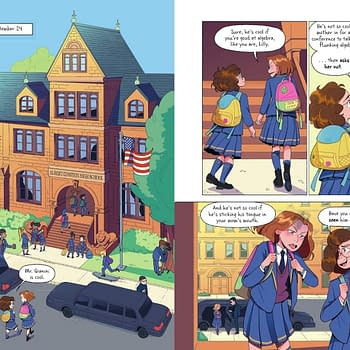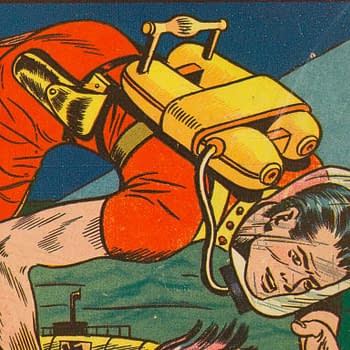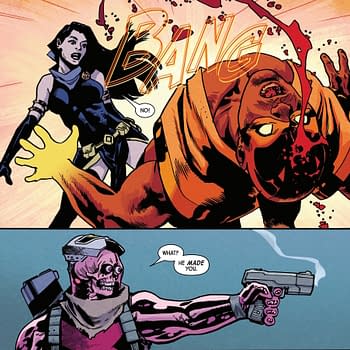Posted in: Comics | Tagged: Comics, django unchained, dynamite, entertainment, Esteve Polls, matt wagner, quentin tarantino, zorro
Saddling Up For An Epic Crossover – Matt Wagner Talks Django / Zorro
My trip to San Diego Comic Con this year ended on Saturday, which meant I was unable to go to the Dynamite panel on Sunday where Quentin Tarantino and Matt Wagner talked about the upcoming crossover event Django / Zorro. But I did get to interview Wagner about the upcoming series and try to get a better idea of what it's like to work with Tarantino and bringing these two western heroes together.

MATT WAGNER: Absolutely! I've been a fan of Quentin's films ever since Reservoir Dogs and a reviewer friend took me along to a press screening of Django. Immediately after the credits started to roll, I turned to my friend and said, "If I was a young black guy (which, obviously, I'm not), I'd see that movie nine-fucking-hundred times!" For one thing, it's Quentin's most straight-up heroic flick. He's dealt with revenge themes in the past of course and centered so many of his films on the seedy underworld of criminal life. But in Django you had a hero released from bondage who then goes on a quest to rescue his true love who's been locked away in an evil castle. That's a really classically heroic set-up. And I particularly loved the final few minutes of the film. In American movies, we're sooooo used to seeing white heroes strut their victory lap at the end and it just felt really great to see a black hero display that same joyful bravado. I think I was already clapping and woo-hooing when Django had his horse do its high-step routine there at the end.
BC: How did you get involved in the project and how was it meeting with Quentin Tarantino?
MW: This whole project was the wacky brain-child of Dynamite owner Nick Barrucci and Reggie Hudlin who was Quentin's producer on both Inglourious Basterds and Django Unchained. These two had known each other for some time and together they cooked up the idea of teaming Django with Zorro; Quentin and I both joke that it must've been the ending "o" in the characters' names. Nick approached me about writing the series but I kind of scoffed at the idea in a "Yeah, right…that'll never happen" sort of way. But, of course, I said that, if they could swing, I'd totally be on board. Skip ahead several months and I'd pretty much forgotten all about this long shot gig when I got an email from Nick that went something like, "We gave all your Zorro books to Quentin and he LOVES them! He wants you to come down for a meeting next week." Well, after I picked my jaw up off the floor, I went down to LA and spent a couple of days at Quentin's house, jamming on what we wanted to do with the project. I gotta say, when we first met it felt like we'd known each other for years. We hit it off immediately and were totally in sync throughout the entire story-session. We're nearly the same age and so have many of the same points of reference. For instance, when I was there, he'd just gone on a buying spree, accumulating stacks and stacks of the oversized B&W Marvel mags from the 70s. I had a ton of those when I was a teen and so we spent quite a bit of time geeking out over how cool they were. We got each other's jokes and we always seemed to go to the same place when plotting out our tale. When Quentin communicates via film and when he first starts working with someone, he wants to screen movies for you to show where his head's at in regards to your upcoming collaboration. So, we also spent a decent amount of time in his incredible screening room, watching a variety of flicks to put us in the Django/Zorro groove.

MW: Well, he's just such a prototypical hero. He predates every other masked hero with a secret identity and he's got ALL the elements that just add up to "cool". He dresses in black, he's an ace swordsman, he's got a magnificent steed, a cave hide-out, a cracking whip AND the incredibly iconic "Z" as his symbol. He's Batman without all the brooding angst. Not to say that he doesn't have to deal with a certain amount of pathos and loss (at least the way I write him), but you're always certain that Zorro is going to triumph in the end, usually with a dashing smile, and thunder off into the sunset in a swirl of dust from Tornado's mighty hooves. I think it's also significant that Zorro doesn't so much fight crime as battle oppression; he's committed to the cause of justice, not vengeance. And, certainly, oppression is a ugly aspect of human society that keeps sadly recurring throughout the ages.
BC: I don't know how many people would have thought of pairing these two western heroes. What do you see in the character of Django that puts him on par with Zorro? What made these two characters seem right to bring together?
MW: Again, it's that theme of oppression. Even though Django operates as a mercenary bounty hunter and his goal in the film was to rescue his lady from her captors, the idea of oppression is a sad and constant fact to every black American, especially in the era just preceding the civil war. So Django, at his very core, is battling oppression every day of his life simply by the virtue of being black. Zorro, on the other hand, is much more deliberate in his crusade against oppression and that seemed to provide a nice dichotomy that we could play with in regards to these two characters. Quentin points out the very exciting possibilities in teaming up one of the most famous classic western characters with one of the most famous contemporary western characters.

MW: They get along famously—much like Quentin and myself. The first issue basically tosses our two heroes together right off the bat and shows how they both become quite intrigued with each other almost immediately. They're both purposeful, quick-to-action and fearless in their pursuits…pretty unique individuals. In the film, the villain Calvin Candie claims that Django is a "one-in-ten-thousand nigger." I think it's safe to say that there's no one quite like Zorro either! Our story is set about a year after the events of Django Unchained so Diego de la Vega is a senior at this point. As a result, Django sees him as something of a mentor to some degree, echoing the sorely missed relationship he had with King Schultz. For his part, Diego admires Django's directness and undaunted brio, perhaps recalling a bit of himself in younger days.
BC: We haven't heard a lot about what the story is going to be. What type of scenario will bring these two together and who is the villain or villains that match up with these two symbols of justice?
MW: Well, we don't want to say too much but our story is based on an actual historical personage who was so larger-than-life as to seem like a comic book character. We're upping the evil factor quite a bit so as to really make him an intriguing villain but the basic gist of story is based in fact.

MW: Pretty much, yeah. It was Quentin who brought the idea for the villain to the table but I'd say we're equally responsible for the thrust and structure of the story. Aside from watching movies together to get in the mood, our story sessions involved sitting either out on his patio/deck or at his kitchen table and just tossing ideas back-and-forth, with me jotting down the stuff that we both liked. Truthfully, there was just such a wealth of good shit flying across the table that there really wasn't much that we ended up rejecting. A lot of "YES! I love that!" going to and fro. After cobbling together the general story outline, I then go and write the actual scripts with Quentin later giving me notes, mostly in regards to the specifics of Django's character and dialogue. Here again, there really hasn't been that much editorializing on his part…we're pretty much in synch. One of the things I really wanted to capture here was the unique quality of narrative that Quentin brings to his films. One of his most familiar tropes is his use of a non-linear storyline (although DU is pretty much linear). I pointed out to him that part of what makes that such an effective narrative technique is that it throws the viewer off-balance and forces them to more actively participate in the film—"Wait-a-minute! What's happening now?" Comics are a different beast than film though and we've already got that interruption in the flow of the narrative enforced by the monthly wait between issues. The reader already knows they're going to have to readjust and catch up every time they open the cover of each new chapter. I suggested a motif that I think should help enhance the shifting viewpoints of Quentin's films and he was all over that in a flash. Again…"YES! I love that!"
BC: As an artist, what is it like writing for another artist as opposed to writing for yourself? And what is it like working with Esteve Polls? What does he bring to the table that made him the right choice for the series?
MW: Well, at this point in my career, I've written for tons of different artist. Both on Grendel and the various stuff I've done for both DC and Dynamite. To me, the difference is apples and oranges…it's all just story-telling. Sometimes I wanna draw that story and sometimes don't. I'd worked with Esteve Polls previously on the first story arc of Dynamite's second Zorro series, Zorro Rides Again. He's a finely detailed draftsman and he really knows and understands the mise-en-scène of a tale set in the American Old West. The mesas, the horses, carriages, frontier towns…when Esteve draws them, you really feel like you're there. Additionally, his treatment of our two main characters is pretty damn spot on as well. He totally nails it. All of it.

MW: Well, in regards to Grendel projects of the near future…how does right now sound? Currently on the comic stands is my latest series that I'm both writing and drawing—Grendel vs The Shadow. It's a crossover event featuring, obviously, my character Grendel facing off with another of the most classic characters of all time, The Shadow. It's a three-issue series published in the prestige-format (48 pgs each) and is colored by my son, Brennan Wagner. I had an absolute blast on that one as well. So far as Mage goes…I've gotta offer my standard response of "Eventually". But I will add…perhaps sooner than you think.
For more on Django / Zorro #1, click here.














